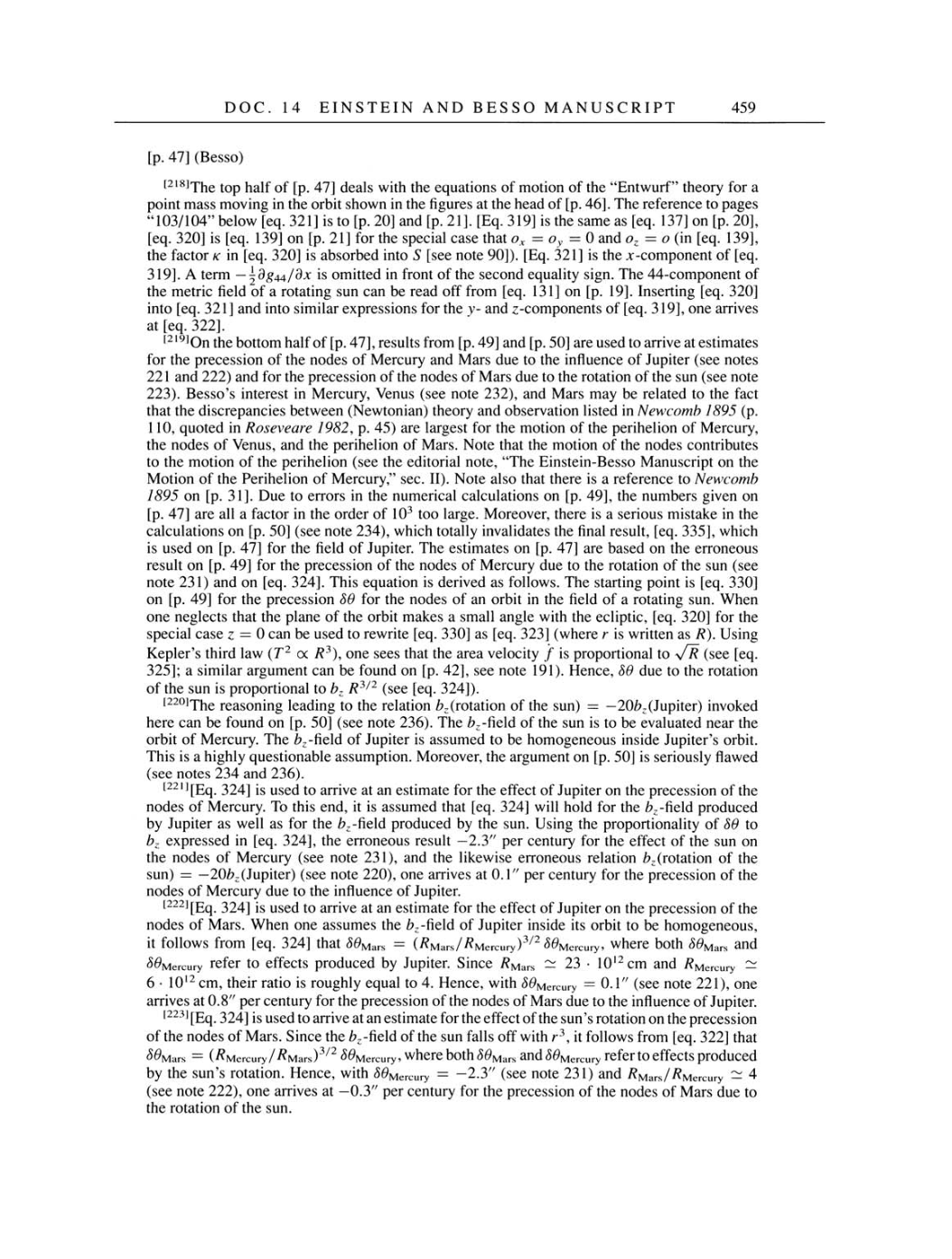DOC.
14
EINSTEIN
AND
BESSO
MANUSCRIPT 459
[p.
47]
(Besso)
[218]The
top
half of
[p.
47]
deals
with
the
equations
of motion of the "Entwurf"
theory
for
a
point
mass
moving
in the
orbit shown
in the
figures
at
the head of
[p.
46].
The reference
to pages
"103/104"
below
[eq. 321]
is
to
[p.
20]
and
[p.
21].
[Eq. 319]
is
the
same as [eq. 137] on
[p.
20],
[eq. 320]
is
[eq. 139]
on
[p. 21]
for the
special
case
that
ox = oy
=
0
and
oz
=
o
(in [eq. 139],
the factor
k
in
[eq. 320]
is
absorbed
into S
[see
note
90]).
[Eq. 321]
is
the
x-component
of
[eq.
319]. A
term
- 1/2dg44/dx
is
omitted in front of
the
second
equality
sign.
The
44-component
of
the metric
field
of
a
rotating
sun can
be
read off from
[eq. 131] on [p. 19].
Inserting
[eq. 320]
into
[eq. 321]
and
into
similar
expressions
for
the
y-
and
z-components
of
[eq. 319], one
arrives
at
[eq. 322].
[219]On the
bottom
half
of
[p.
47],
results from
[p. 49]
and
[p. 50] are
used
to
arrive
at
estimates
for the
precession
of the
nodes
of
Mercury
and
Mars
due
to
the influence of
Jupiter (see notes
221
and
222) and
for the
precession
of
the
nodes of Mars due
to
the rotation of
the
sun
(see
note
223).
Besso's interest in
Mercury,
Venus
(see
note 232),
and
Mars
may
be
related
to the
fact
that the
discrepancies
between
(Newtonian) theory
and observation listed
in Newcomb 1895
(p.
110, quoted
in Roseveare 1982,
p.
45)
are
largest
for
the motion of
the perihelion
of
Mercury,
the nodes of
Venus,
and the
perihelion
of Mars. Note that
the
motion of the
nodes contributes
to
the motion of the
perihelion (see
the editorial
note,
"The Einstein-Besso
Manuscript
on
the
Motion of the Perihelion of
Mercury,"
sec. II).
Note also
that
there
is
a
reference
to Newcomb
1895
on [p. 31].
Due
to
errors
in
the numerical calculations
on [p.
49],
the numbers
given on
[p.
47]
are
all
a
factor
in
the order of
103
too
large.
Moreover,
there
is
a
serious mistake
in the
calculations
on [p.
50]
(see note 234),
which
totally
invalidates the
final result,
[eq.
335],
which
is
used
on
[p.
47]
for the
field
of
Jupiter.
The estimates
on
[p.
47]
are
based
on
the
erroneous
result
on [p.
49]
for the
precession
of
the
nodes of
Mercury
due to
the rotation of
the
sun
(see
note 231)
and
on [eq.
324].
This
equation is
derived
as
follows. The
starting point is
[eq.
330]
on [p.
49]
for the
precession
80
for the nodes of
an
orbit
in
the
field
of
a
rotating
sun.
When
one
neglects
that the
plane
of the orbit makes
a
small
angle
with the
ecliptic,
[eq. 320]
for
the
special
case z
=
0
can
be
used
to
rewrite
[eq.
330]
as [eq.
323]
(where
r
is
written
as R). Using
Kepler's
third
law
(T2 a R3), one sees
that
the
area
velocity
f
is
proportional to
\fR
(see
[eq.
325]; a
similar
argument
can
be
found
on [p.
42],
see
note
191).
Hence, 80 due to the
rotation
of
the
sun is proportional
to
bz
R3/2
(see
[eq.
324]).
[220]The reasoning leading to
the relation bz(rotation of
the
sun)
=
-20bz(Jupiter)
invoked
here
can
be
found
on [p.
50] (see
note
236).
The
bz-field
of
the
sun
is
to
be
evaluated
near
the
orbit of
Mercury.
The
bz-field
of
Jupiter
is
assumed
to
be
homogeneous
inside
Jupiter's
orbit.
This
is
a
highly questionable assumption.
Moreover,
the
argument
on [p. 50]
is
seriously
flawed
(see
notes
234 and
236).
[221][Eq.
324]
is
used
to
arrive
at
an
estimate for the effect of
Jupiter
on
the
precession
of the
nodes of
Mercury.
To this end, it
is
assumed that
[eq. 324]
will
hold for the
bz-field produced
by
Jupiter as
well
as
for the
bz-field
produced
by
the
sun.
Using
the
proportionality
of
80 to
bz
expressed
in
[eq.
324],
the
erroneous
result -2.3"
per century
for the effect of
the
sun on
the nodes of
Mercury
(see
note
231), and
the likewise
erroneous
relation
bz(rotation
of the
sun)
=
-20bz(Jupiter)
(see note 220),
one
arrives
at
0.1"
per century
for the
precession
of the
nodes of
Mercury
due
to
the
influence of
Jupiter.
[222][Eq.
324]
is
used
to
arrive
at
an
estimate for the effect of
Jupiter
on
the
precession
of
the
nodes of Mars. When
one assumes
the
bz-field
of
Jupiter
inside
its
orbit
to
be
homogeneous,
it
follows from
[eq. 324]
that
80Mars
=
(RMars/RMercury)3/2
80Mercury,
where both
80Mars
and
5#Mercury
refer
to
effects
produced
by
Jupiter.
Since
RMars
-
23
•
1012cm and
RMercury
-
6
•
1012cm,
their ratio
is
roughly equal
to 4. Hence,
with
5#Mercury =
0.1"
(see
note 221),
one
arrives
at
0.8"
per century
for the
precession
of
the
nodes of
Mars due to the influence of
Jupiter.
[223][Eq.
324]
is
used
to arrive at
an
estimate
for
the
effect of
the
sun's rotation
on
the
precession
of
the
nodes of
Mars.
Since the
bz-field
of
the
sun
falls off
with r3,
it
follows from
[eq. 322]
that
S0Mars
=
(RMercury/RMars)
3/2
S0Mercury,
where both
S0Mars
and
5$Mercury
refer
to
effects
produced
by
the sun's rotation.
Hence,
with
80Mercury =
-2.3"
(see
note 231)
and
RMars/RMercury
-
4
(see note 222),
one
arrives
at
-0.3"
per century
for the
precession
of
the
nodes of
Mars
due to
the
rotation of the
sun.
